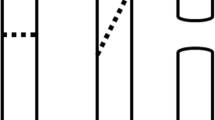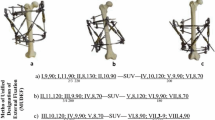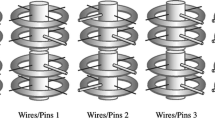Abstract
Purpose
External fixators are easy to apply and maximize soft tissue preservation. However, frames need providing an adequate stiffness in order to avoid excessive interfragmentary movement during the healing period. We characterized the stiffness of four different configurations of the newly developed Hoffmann 3 external fixation system.
Methods
A synthetic fracture gap model was stabilized using four different frame configurations: a double-∅ 11 mm rod configuration (group DR), a hybrid double-∅ 8 mm rod configuration (group H), a single ∅ 11 mm rod direct link configuration (group DL) and a single ∅ 11 mm rod side arm configuration (group SA). The stiffness of each configuration was measured under anterior-posterior bending, medial–lateral bending and axial torsion loading directions and the results statistically compared.
Results
The basic frame construct (group DR) showed the highest bending and torsional stiffness properties while the single rod side arm configuration (group SA) the lowest.
Conclusions
The diameter and the amount of used connecting rods as well as the adequate placement of these rods towards the main loading directions determine the construct stiffness. These results could help the surgeons estimating how different frames can potentially affect the interfragmentary motion. This information might help in choosing specific configuration when treating different fracture types on given patients.


Similar content being viewed by others
References
Pape HC, Tornetta P III, Tarkin I, Tzioupis C, Sabeson V, Olson SA. Timing of fracture fixation in multitrauma patients: the role of early total care and damage control surgery. J Am Acad Orthop Surg. 2009;17(9):541–9.
Pape HC, Giannoudis PV, Krettek C, Trentz O. Timing of fixation of major fractures in blunt polytrauma: role of conventional indicators in clinical decision making. J Orthop Trauma. 2005;19(8):551–62.
Schreiber VM, Tarkin IS, Hildebrand F, et al. The timing of definitive fixation for major fractures in polytrauma—a matched-pair comparison between a US and European level I centres: analysis of current fracture management practice in polytrauma. Injury. 2011;42(7):650–4.
Chao EY, Aro HT, Lewallen DG, Kelly PJ. The effect of rigidity on fracture healing in external fixation. Clin Orthop Relat Res. 1989;241:24–35.
Moss DP, Tejwani NC. Biomechanics of external fixation: a review of the literature. Bull NYU Hosp Jt Dis. 2007;65(4):294–9.
Yamagishi M, Yoshimura Y. The biomechanics of fracture healing. J Bone Joint Surg Am. 1955;37-A((5)):1035–68.
Sladicka SJ, Duffin SR, Erpelding JM. A biomechanical strength comparison of external fixators. J Trauma. 1998;44(6):965–9.
Behrens F, Johnson WD, Koch TW, Kovacevic N. Bending stiffness of unilateral and bilateral fixator frames. Clin Orthop Relat Res. 1983;178:103–10.
ASTM International. Standard Specification and test methods for external skeletal fixation devices. Designation. 2007;F1541(02):1–31.
Behrens F, Johnson WD, Koch TW, Kovacevic N. Bending stiffness of unilateral and bilateral fixator frames. Clin Orthop Relat Res. 1983;178:103–10.
Behrens F, Searls K. External fixation of the tibia. Basic concepts and prospective evaluation. J Bone Joint Surg Br. 1986;68(2):246–54.
Mani US, Sabatino CT, Sabharwal S, Svach DJ, Suslak A, Behrens FF. Biomechanical comparison of flexible stainless steel and titanium nails with external fixation using a femur fracture model. J Pediatr Orthop. 2006;26(2):182–7.
Baran O, Havitcioglu H, Tatari H, Cecen B. The stiffness characteristics of hybrid Ilizarov fixators. J Biomech. 2008;41(14):2960–3.
Mani US, Sabatino CT, Sabharwal S, Svach DJ, Suslak A, Behrens FF. Biomechanical comparison of flexible stainless steel and titanium nails with external fixation using a femur fracture model. J Pediatr Orthop. 2006;26(2):182–7.
Behrens F, Johnson WD, Koch TW, Kovacevic N. Bending stiffness of unilateral and bilateral fixator frames. Clin Orthop Relat Res. 1983;178:103–10.
Chao EY, Aro HT, Lewallen DG, Kelly PJ. The effect of rigidity on fracture healing in external fixation. Clin Orthop Relat Res. 1989;241:24–35.
Behrens F, Johnson W. Unilateral external fixation. Methods to increase and reduce frame stiffness. Clin Orthop Relat Res. 1989;241:48–56.
Acknowledgement
We thank Mr. Marcus Stoffel, PhD, of the Institute of General Mechanics of the RWTH Aachen University for his thorough supervision of the mechanical tests. We would like to thank Robert Leo Garrison, MD for the translational work and clinical advisory.
Conflict of interest
Stryker Osteosynthesis Kiel, Germany, sponsored this study. The tests were accompanied and supported by Mr. Markus Behrens, biomechanical engineer, Stryker Osteosynthesis, Switzerland. There was no influence by the sponsor on the submitted manuscript. The role of the sponsor was purely to advise in terms of handling of the fixator system components. There are no further conflicts of interest.
Ethical standards
The manuscript does not contain clinical studies or patient data. No human or animal specimens were used. All authors certify that they comply with the ethical guidelines for authorship and publishing in the European Journal of Trauma and Emergency Surgery.
Author information
Authors and Affiliations
Corresponding author
Rights and permissions
About this article
Cite this article
Sellei, R.M., Kobbe, P., Dienstknecht, T. et al. Biomechanical properties of different external fixator frame configurations. Eur J Trauma Emerg Surg 41, 313–318 (2015). https://doi.org/10.1007/s00068-014-0436-1
Received:
Accepted:
Published:
Issue Date:
DOI: https://doi.org/10.1007/s00068-014-0436-1




